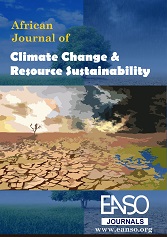Identification of Climate Change Risks to Surface and Groundwater Resources across the Central African Republic and Resilience Measures
Résumé
The extensive hydrological and hydrogeological systems across the Central African Republic (CAR) provide essential urban and rural water supplies for the populations across the country. Hydrological and hydrogeological studies during the last 20 years are extremely limited, in part due to the complex security and socio-economic context. As a result, significant uncertainties exist related to water resource availability and infrastructure management. This paper examined the recent evolution of the meteorological, hydrological, and hydrogeological regimes across CAR and the potential future impacts of climate change on surface and water resource availability. This was undertaken by analyzing the available regional hydrometry data and using regional climate change projections to evaluate changes to rainfall and evapotranspiration patterns by 2050. A lack of long-term monitoring data and operational monitoring systems prevents a detailed assessment of these risks at local levels. Although the national scale findings suggest that water resources may slightly increase over the next 40 years, significant local risks remain due to intensifying, increasingly variable rainfall, and increasing demographic pressures. The lack of functional, national-scale water resource monitoring systems contributes to the fragile resilience of the populations across CAR in the face of increased climate-associated risks. Recommendations are included for measures to help characterize and manage the potential risks in the long-term including the implementation of robust water resource monitoring systems
##plugins.generic.usageStats.downloads##
Références
Boulvert, Y., and Buffard-Morel, J.-M. (1987). Oro-hydrographic map of the Central African Republic 1:1,000,000. ORSTOM.
Haensler, A., Saeed, F. and Jacob, D. (2013): Assessment of projected climate change signals over central Africa based on a multitude of global and regional climate projections. In: Climate Change Scenarios for the Congo Basin. [Haensler A., Jacob D., Kabat P., Ludwig F. (eds.)]. Climate Service Centre Report No. 11, Hamburg, Germany, ISSN: 2192-4058.
Hargreaves, G.H., and Samani, Z.A. (1985) Reference Crop Evapotranspiration from Temperature. Applied Engineering in Agriculture, 1, 96-99. http://dx.doi.org/10.13031/2013.26773.
IPCC, 2021: Climate Change 2021: The Physical Science Basis. Contribution of Working Group I to the Sixth Assessment Report of the Intergovernmental Panel on Climate Change [Masson-Delmotte, V., P. Zhai, A. Pirani, S.L. Connors, C. Péan, S. Berger, N. Caud, Y. Chen, L. Goldfarb, M.I. Gomis, M. Huang, K. Leitzell, E. Lonnoy, J.B.R. Matthews, T.K. Maycock, T. Waterfield, O. Yelekçi, R. Yu, and B. Zhou (eds.)]. Cambridge University Press, Cambridge, United Kingdom and New York, NY, USA, 2391 pp. doi:10.1017/9781009157896.
Karam S., Seidou O., Nagabhatla N., Perera D., Tshimanga RM. (2022) Assessing the impacts of climate change on climatic extremes in the Congo River Basin. Clim Change. 2022;170(3-4):40. doi: 10.1007/s10584-022-03326-x.
Maidment, R. I., D. Grimes, E. Black, E. Tarnavsky, M. Young, H. Greatrex, R. P. Allan et al. (2017). A new, long-term daily satellite-based rainfall dataset for operational monitoring in Africa. Nature Scientific Data, 4: 170063. DOI: 10.1038/sdata.2017.63.
Practica Foundation, UNICEF and Enterprise Works/VITA. 2014. République Centrafricaine: Etude de faisabilité des forages manuels: identification des zones potentiellement favorables. Practica/Enterpriseworks/VITA/UNICEF.
Singer M., Dagmawi Asfaw, Rafael Rosolem, Mark O. Cuthbert, Diego G. Miralles, Edisson Quichimbo Miguitama, Dave MacLeod, Katerina Michaelides (2020): Hourly potential evapotranspiration (hPET) at 0.1degs grid resolution for the global land surface from 1981- present. https://doi.org/10.5523/bris.qb8ujazzda0s2aykkv0oq0ctp
REACH, 2020. Susceptibilité et risque d'inondations en République Centrafricaine - Méthodologie d'analyse.
SODECA provided estimated water supply volumes (personnel communication, February 2023).
Thornthwaite, C. (1948). An Approach toward a Rational Classification of Climate, Geogr. Rev., 38, 55–94, https://doi.org/10.2307/210739.
Thrasher, B., Wang, W., Michaelis, A. et al. NASA Global Daily Downscaled Projections, CMIP6. Sci Data 9, 262 (2022). https://doi.org/10.1038/s41597-022-01393-4.
UNICEF. 2010. Etude de faisabilité des forages manuels, identification des zones potentiellement favorables. DGH Bangui, 30p.
United Nations. 1988. United Nations Department of Technical Cooperation for Development and Economic Commission for Africa. Natural Resources/Water Series No.18, ST/TCD/5.
Upton K, Ó Dochartaigh BÉ and Bellwood-Howard, I. 2018. L'Atlas de l'eau souterraine en Afrique: Hydrogéologie de la République centrafricaine. British Geological Survey.
WHO, UNICEF, World Bank. 2022. State of the world’s drinking water: an urgent call to action to accelerate progress on ensuring safe drinking water for all. Geneva: World Health Organization. Licence: CC BY-NC-SA 3.0 IGO
The World Bank Group (2021). Climate Risk Profile: Central African Republic.
Copyright (c) 2024 Paul Evans, Blandine L’hévéder

Ce travail est disponible sous la licence Creative Commons Attribution 4.0 International .




























